Originally Published October 14, 1999. Republished on October 2, 2019, in memory and honor of the lives lost at Bradley International Airport this morning.
All images in the main story below are thumbnails only

It was Hartford, Connecticut, USA, but with the low clouds, cold rain, and fog, it seemed like it could have been Thorpe Abbot, Deenethorpe, or any of the other notoriously foggy WWII bomber fields scattered across England in 1943. Looking out at the tarmac and seeing a B-24 Liberator and a B-17 Flying Fortress weathering the dismal sky just seemed to transport myself and everyone else into another era.
Rain or no rain, several hundred people came to Brainard Airport on this raw New England day to get a glimpse of history, courtesy of the Collings Foundation of Stow, Massachusetts. Although it also runs a museum and a number of classic aircraft restoration projects, the Foundation is best known for its duel touring bombers.
It’s pretty hard to miss them, too. The B-24, “The Dragon and His Tail,” is painted up in the complex, plane-length design replicated from the famous Liberator in the 43rd Bomb Group with the same name and artwork. The Collings B-17 is replicating the Nine-O-Nine, a famed 91st Bomb Group Flying Fortress that flew 140 missions and 1,129 hours, including 18 trips to Berlin, without the loss of a crew or a mission abort. Both pretty easily stand out among the Cessnas, Mooneys, and Lears of the modern world they are stranded in.


The Nose and Tail of “Nine-O-Nine”
I was scheduled to take a ride in the B-24 this day, but as I walked from the sheltered building out into the rain, it was obvious we weren’t going anywhere. After introducing myself to some of the Collings crew, I decided to make the most of it and spend some time admiring the planes, especially after reading so much about them in anticipation of the flight.
As I blended in with the crowd, it didn’t take long to realize that there were a lot of older men here, many with their children and their children’s children. Always looking for a story, I moved my way close to several, hoping to catch those fleeting images of history from the old crews themselves. As the rain got heavier, the crowds began to migrate under the wings and any other cover they could find. I did the same, praying that the rain wouldn’t ruin my notes or camera, both of which were busy capturing the scene.
It was during one of the heavier downpours that I saw him. Frail-looking, hunched over, and drenching wet, an old man stood right in front of the Liberator, staring straight into it. Even from a distance, I could see he had the shoulder patch of the 15th Air Force on his jacket. I had to walk back that way anyway, so I moved over to him and struck up a conversation.
“You fly in the 15th? So did my grandfather.”
“Yep.” He slowly turned towards me. “Where’d he fly out of?”
“Spinazzola, Italy,” I answered, stumbling over the pronunciation of the town.
“That’s close enough,” he replied. “I was in Italy too. Flew in one of these. Left waist.” His voice lowered a bit as every word came out with a purpose. When he was finished, there was a long pause, and I quickly got the hint.
“It was very nice meeting you,” I said as I stuck out my hand. “Thank you for serving.” As I started to walk away, he spoke again.
“Great airplane, the -24. No one gave it enough credit.”
“Definitely. No one gives you guys enough credit either.”
He smiled a crack. Another long pause. By this time the rain had died down a bit, and another vet, this one sporting a B-26 hat, came over to talk and listen. The B-24 vet spoke again.
“I got shot down the mission after we hit Ploesti. A Focke-Wulf snuck in behind us. All but one of us got out.”
“I’m very sorry. Were you captured?”
“Spent a year as a POW.” His eyes never left the plane. “Yep.”
The B-26 crewman was now fighting back tears. By that point my eyes were wet too, and it wasn’t from the rain.
“Did you do OK while you were a POW?” he asked.
“Well,” the man answered with a quiet voice and a smile, “I’m here.”
“God bless you, buddy,” the B-26 crewman choked out, and then he grabbed him in a bear hug and cried. As he walked away towards his own family, the B-26 crewman turned to me, pointed with his finger, and said, “Don’t you ever forget….this man is a hero. Don’t you ever forget.”
He was one of many at Brainard Field that Sunday.
Over the course of two days, I spent almost six hours with the volunteer crew from the Collings Foundation and their visitors. Besides the birth of my child, I have never had a more moving experience. From the way the Collings folks talked about their airplanes, to the courageous modesty of the vets, to their bewildered family members, I was moved by the genuineness of it all.
For four hours that Sunday, I stood under the wing of the B-24 with Collings volunteer pilot John Rising as he collected a small fee which allowed the visitors to walk around and through the planes. Along the way, he and I talked with almost everyone who came by to see and touch these rare aircraft.
If you can envision a WWII bomber pilot from the movies, Rising, 35, fits the bill. Tall, fit, and confident looking, he flies an Airbus 320 for a living, although he’s been with the Foundation for 12 years in both a full-time and volunteer capacity. Fresh on a four-day break from his “real job” at a charter airline, Rising is the Foundation’s B-17 pilot for this leg of the trip, heading along the East Coast down towards his home near Atlanta, where his family and two cats (“Pratt” and “Whitney”) are now. He’s got about 5,000 hours of flight time under his belt, including about 1,200 hours each in the B-24 and B-17.
“I never get bored,” he says while taking the money and stamping hands, although at times it’s hard to imagine how he couldn’t. On this day, Rising is the Collings crew member front and center, and he’s being bombarded with questions from visitors are simple as “Which one is the B-24?” to “How does the wing aspect ratio of the B-24 compare to the B-17?” He handles them all in stride, although I pitch in to deal with the basic ones after a while. Other Collings crew members are working around the planes, checking and rechecking their supplies, coordinating today’s scheduled rides up in the bombers that are now likely to be rained out, talking to the visitors, or working a table inside.
In between visitors, John tells me of how he first became involved in the Foundation, during a summer break from college when he helped coordinate media relations for the tour as a volunteer. After that, the “bug” bit; he got his pilot’s license and worked his way up the Collings ranks through flight engineer to copilot and pilot / captain of both the B-24 and the B-17.
“They’re my mistresses,” he says with a laugh and a shrug.

The Nose of “The Dragon and His Tail”
(nose art nudity)
Talking to almost everyone, we’re both susceptible to goosebumps numerous times this afternoon. One vet brings up his leather bound photo album, ready to show us the Pacific War seen from his camera. It could fill a history book.
“Here’s Charles Lindbergh. Geez, he turned his head right when I took this picture, but that’s him,” he points out, tapping at the picture of a man in a P-38. Howard was an armorer assigned to B-24s and later P-38s, and along the way captured some incredible moments in the war on film, like a photo of the original “The Dragon and His Tail” and the Japanese “Betty” bomber that flew the surrendering Japanese delegation into Ie Shima.
Later, another older man comes up and pays for himself and for “someone else.”
“Is he coming later? Tell him to mention to me that you paid,” John points out.
“No, I don’t think he’s coming later. My brother died on a B-24 in the war. He would have wanted to see this.”
John and I are at a loss for words as the old man brings up his daughter and granddaughter and starts to show them the planes.
“I never get bored doing this,” John repeats as he dodges another drop of water seeping through the wing of the Liberator.
Another person who doesn’t get bored is Phil Haskell. Phil started with the Foundation in 1986, helping to restore the B-24. In 1992, he decided to join the planes for their annual 10 1/2 month tour…that was seven years ago.
“I don’t do the work; I just make sure other people do theirs,” he smiles, after delivering the understatement of the year. Phil is the guy who keeps the operation running on the road and when he’s not talking to the mechanics and pilots, he’s lugging boxes of oil out for the planes, coordinating the visits with local FBOs and airports, making sure the local Foundation volunteers have found rooms and restaurants for the crews (while they’re generally not paid, they get room and board while on the road), ensuring the airport has fuel, tracking the planes’ supplies of spare parts, and generally keeping things running smoothly.
This isn’t easy even if you own a small plane, not to mention two beasts that burn a gallon of oil per hour per engine and which run up an $1,800 fuel bill after a half-day of flying. The Foundation’s bombers are remarkably self-sufficient logistically. With the exception of a full engine and a spare tire, the crews carry everything with them that they may need on the road: spare magnetos, plugs, starters, the whole works. It’s all crammed into tight corners of the planes, up in the nose, or wherever there’s room.
Phil’s not a pilot with Collings (although he flew fixed wing planes in the Army in the early ’60s) but he is as vital to the planes as the flight crews. Each of these bombers costs $2,000 per hour to fly, and the Foundation relies on paid 40-minute “flight experiences” and ground tours to pay their bills. Phil makes sure the crews and mechanics have what they need to keep the show moving safely and reliably.

Touring “Nine-O-Nine”
Any nonprofit organization needs volunteers, and Collings seems to have found some of the most devoted in the world. Between 6 to 12 volunteers are with the Foundation’s planes at any one time, and Bill Strawn of Florida is a classic example. After taking one of the paid rides in the bombers in 1996, he quit his day job and joined the Collings crew, volunteering for the last three years to work on the planes and help with visitors.
“Eh, you can always find another job,” he shrugs.
The man who made all of this possible is Bob Collings, who coordinates the entire Foundation from a farm in Massachusetts.
From an organization that started out in 1979 to support “living history” events as diverse as antique car rallies and winter ice-cutting festivals, the Collings Foundation has turned into one of the world’s most prominent restorers of classic aircraft. In addition to the B-17 and B-24, Collings operates a Bleroit, Fokker DR-1, PT-17 Stearman, AT-6 Texan, TBM torpedo bomber, A-26 Invader, B-25 Mitchell, Fiesler Storch, F4U Corsair, and most recently, an F-4D Phantom dedicated to Vietnam veterans.
The Foundation depends solely on private funding and receives donations from individuals and groups from across the country. A number of companies have donated gear for the aircraft, including the rare spark plugs, an original Norden bombsight, and other hard-to-find components.
The planes are Collings’ babies. After buying the B-24 from an English aircraft collector, he shipped the plane across the ocean by ship. The 64-foot-long fuselage and center wing were set on cradles, and two forty-foot containers contained the reminder of the aircraft. The restoration involved the complete disassembly of the B-24 and work on about 80 percent of its 1,200,000 parts. More than $1.3 million, 97,000 man hours, and 420,000 rivets later, the B-24, which had previously served the RAF in the Pacific Theater and later the Indian Air Force, took off as the “All American” (her name was changed to “The Dragon and His Tail” in 1999). She is believed to be one of only about ten B-24s in the world and the only true B-24 Liberator flying. More than 18,000 B-24s were produced.
The Collings B-17 has had no less of an amazing history. Produced too late to see war duty, she served as an Air/Sea Rescue plane and later in the Military Air Transport Service. In 1952, the aircraft was instrumented and subjected to three different nuclear explosions. After 13 years of “cooling down,” #44-83575 was sold as part of an 800-ton scrap pile and restoration began. For the next 20 years, she pressed on as a fire bomber before being sold to Collings in 1986. In 1987, she suffered a non-fatal crash landing in Pennsylvania which caused substantial damage to the nose, landing gear, wing, nacelles, bomb bay, fuselage, and ball turret. With nacelles from another B-17, thousands of volunteer hours, and donations from individuals and corporations, she proudly took off again.
Today, the planes are on tour, making stops in more than 125 cities in 35 states across the continental United States this year alone. In the past decade, they’ve made more than 1,200 stops. They’ve been out since January 1999, and are currently on their way back south, where the bombers receive a thorough annual inspection and overhaul for almost two months in Florida. They have no fixed base or hangar anywhere in the US.

The Waist Gunner’s Position on the B-24,
Boarded Up and Facing Aft
Proceeds are raised on the road, between the $7 admission ($3 for children) to tour the planes, which basically is gas money on a good stop, as well as the $350 “flight experiences.” Various sponsorships are also available on the aircraft itself, and you can see those names painted prominently on the bomb bay doors and near the positions often manned by the sponsors themselves during the war. At each stop, a PX is also set up, selling B-24 and B-17 memorabilia.
On this particular day, the PX supplies are running low, since a lot of people came to see the planes depart at 2 PM and were stuck inside. As the weather goes from bad to worse, the crowds start to die down and the Collings crew does one final check of the weather at our planned destination, Waterbury-Oxford Airport. There is no bravado here; although the planes are capable of IFR flight and all of the Foundation’s 30 volunteer or paid pilots are IFR-rated, there’s no need to risk flying in bad weather in planes as priceless as these two. Even with the visibility improving, John does a last minute check of the weather and tells me that it’s a no-go. The new departure time is 8:30 AM the next morning.
I should have been disappointed….I had waited for this moment seemingly forever. Part of me wanted to go. Part of me wanted to play it safe. But as I looked through my notes of the day, I realized that the conversations I had heard and participated in were as precious as a ride in these planes. Somewhere along the way, the planes, the Collings Foundation, and the visitors all blended into one fantastic experience.

“The Dragon and His Tail”
(nose art nudity)
As my wife and daughter drove up to the terminal to pick up this cold, wet reporter for a hot shower and a cup of coffee, I felt a connection. Not just to the planes, or to the men who fought in them, but to the past. The armchair quarterbacks will always second-guess history, and the memories of what happened 50 years ago will fade and die away with each passing day, but nothing can ever repay the men who flew, fought, and died in these in the war. However, thanks to groups like the Collings Foundation, what those planes and men did will live on, hopefully well into the future. They deserve the support of anyone vaguely concerned about freedom, aviation, and our history. They are American treasures.
PART TWO: FLYING THE DRAGON

The front that had delivered all of the rain had passed through over the night, and the scene at 7:30 AM at Brainard Field was calm. As the sun struggled to break out of the remaining clouds, “Nine-O-Nine” and “The Dragon and His Tail” were there on the tarmac as I expected them to be…part of me worried I would pull into the airport and find the Collings crew had moved them already.


Nine-O-Nine and “The Dragon And His Tail”
(nose art nudity)
A small crowd, mostly people who came to see them take off yesterday, was already gathered. There were two workers from nearby Pratt and Whitney who kept checking their watches, since they had to be at work at nine. A father brought his two young sons. A couple of passengers waited for their corporate pilot to arrive. They all couldn’t help but look at these two magnificent planes almost daring the sky to ground them again.
The Collings gang rolled in around 8:15, as they told me they would. As they unpacked their rental SUVs and started to preflight the planes, B-17 pilot John Rising came into the terminal to check on the weather at Waterbury-Oxford and other nearby airports. As he walked by, he gave a big smile, looked up at the clearing sky, and asked me, “So, you glad we waited to fly NOW?”

Preflighting the B-24
Preflight went smoothly, and crews climbed up on the wings, removed covers from the B-24’s cockpit and turret, checked the fuel, rotated the props around by hand, and did everything else you need to do to get a 50-year-old airplane up and running. Others loaded their gear in and strapped everything down. I was happy to see them remove the covers from the B-24’s waist positions and swing the .50 caliber machine guns out into position. There was never any doubt which plane I wanted to fly on, and seeing the open ports now made me want it even more. For the first time in 54 years, a Sponauer would fly on a Liberator.
There’s an old story about the B-24 first being designed as a seaplane. However, when the designers saw how much it leaked, they made it into a bomber. As the electric motors for the bomb bay doors whined, a small amount of water poured out of the bay. Given how wet I got the day before standing UNDER the wing, I wasn’t totally shocked. When I asked one of the Collings crew if I should wear a jacket for the flight, he smiled back, “Yeah, expect some wind and water inside.”
There would be five passengers on this hop from Hartford to Waterbury-Oxford: myself, B-24 vet and Collings volunteer Walt Hushak, his daughter, and two others. A reporter from a local paper was due to fly with us too, but as we stood around waiting, Dee Brush, who coordinates the paid “flight experiences” for Collings, reminded the crews that there were already people waiting in Waterbury for their rides, since so many had been rained out the day before.
With that urging, Bill Strawn gave us the briefing… Fasten your seatbelt for takeoff and landing. Stay in your seats until you’re airborne and you get the signal that it’s OK to move about. When we’re about to land, you’ll get another signal…get back to your seats and buckle in. When we land and taxi, get ready to move and disembark quickly. When leaving the aircraft, walk aft and not forward. Avoid walking into spinning props, as it tends to ruin your clothes.
Bill told us that our B-24 pilot for today was 25-year-old Rob Collings, son of Foundation President Bob Collings. With more than 800 hours of flight time in the B-24, Rob is probably one of the highest-hour Liberator pilots in the world today under the age of 70 and may even be the youngest. [AUTHOR’S NOTE: Any thoughts you may have that Rob is too young to fly this plane should be put to rest when you recall that many, if not most, of the crews who took the Liberator to war were 25 or under.]
With those words, and after informing us that there would be neither an in-flight movie nor peanuts, he led us to the B-24’s open bomb bay doors. One by one, we crouched down, shimmied under, and stood in the bay itself, right next to a rack of several “show” bombs. With a small step up, we each climbed up onto the narrow catwalk that ran the length of the bay and which separated the rear gunners from the crew in the front of the aircraft. Turning aft, I squeezed my 6 foot 6 frame through a 2-inch tall opening (OK, so it was probably 4 feet tall, but it felt like 2 inches!), up a step, and into the comparatively open aft section of The Dragon.
The first thing that struck me from being inside was the small size of the whole airframe. I had always assumed that room was tight inside, but looking at these planes from the outside, you don’t get an appreciation for how close the crew were to each other. Being in one sets you straight.
Three of us were asked to sit on a small bench seat / shelf above the small door we just came through, with our backs to the aft bulkhead of the bomb bay. Being the tallest, I took center seat, with my legs dangling down into the doorway. Walt grabbed the seat to my right, his daughter to my left, and the other two passengers were placed next to the waist guns, facing aft with their backs against a board mounted as a backrest.
Bill came up as well, giving us some more words of warning. While we’re in flight, you are free to move around from the tail turret to the front of the bomb bay. Do not step off the catwalk and onto the closed bomb bay doors…they will not support your weight and you will have a long next step down. Do not step on anything marked with “No Step.” Hold onto something solid as you’re moving throughout the fuselage. You can step on the rear access door, as it will be locked and will support your weight. Call out when you are buckled in and ready for takeoff. The seatbelts are military-style straps, and the seat, while padded, is not something you’d want to sit on for a 15 hour flight. We all found our respective straps and adjusted them to fit.
As I soaked it all in and buckled up, I looked around much more closely than I had on the walk-through the day before. The yellow oxygen containers were easy enough to see the first time, but now I also noticed the small green handheld oxygen canisters the crew would use when they had to walk from the front to the back of the aircraft. I had also always known that the ball turret gunners were small, but looking at the retracted turret, I couldn’t even imagine how anyone could fit in that thing.
From my seat, I had a limited vantage point out the waist ports, but I could also bend down and see out two smaller windows near my knee level. Walt politely offered me cotton for my ears, but this was one sound that I didn’t want to miss.
Walt and I started talking. A B-24 pilot, he flew several missions in the Pacific with the 7th Air Force, and spent some time after the war in trainers. He politely pointed out little features of the interior new for me….the ammo boxes for the waist guns, the turret mechanism, and the control cables that snaked out from nowhere and led to the tail of the plane. Forget “fly by wire,” this is “fly by cable!” I was amazed how vulnerable the cables were…in fact, I was amazed how vulnerable the whole interior felt. The thin skin of the B-24 was easily pierced by bullets, flak shrapnel, and debris, and it didn’t take much to imagine holes being punched through the dark green paint, letting in sunlight and wind and trailing destruction as the rounds passed through.
Catching me by surprise, the four Pratt and Whitney 1,200 hp engines roared to life, and I felt a sensation unlike any jetliner, helicopter, or small plane I have flown in before. I vibrated……I don’t mean shook rapidly, but instead my whole body became part of the plane, rocking gently back and forth as the engines screamed louder and loader. With a small jolt, “The Dragon and His Tail” lurched forward, leaving the crowd and Nine-O-Nine behind.
I leaned forward as we taxied out and saw the beautiful sight of the B-17 lining up behind us, all four yellow-tipped props spinning madly. It was an awe-inspiring sight and one that will stay burned in my mind for a long time.
Rob brought the Liberator to the end of the runway, and let Nine-O-Nine pull up alongside to my right (the port side, since I was facing aft). Looking out the window and seeing the grass behind us moving in waves from the eight mighty engines sent chills down my spine, and as he edged the throttles forward, the noise became deafening and beautiful. The plane lurched back, like a sprinter waiting for the starting shot. In an instant, the brakes were off, the engines roared louder, and The Dragon was unchained.
I was stunned at how quickly the B-24 responded, shooting down the runway, reaching 110 mph and lifting off, wings grabbing the air and pulling us skyward. Looking down through the gap around the ball turret below me, I watched the ground slide away as we climbed. We rapidly reached altitude as we crossed the Connecticut River, and Walt was the first one to unbuckle his belt and scamper back to the waist guns. His daughter and I trailed, struggling to find our footing as the plane bounced around a little and banked to the west.
Reaching the starboard gun, I looked out at the City of Hartford as we drifted by. I had briefly considered taking my camcorder up on the flight, but ultimately decided against it. I immediately realized what a good decision that was….some things have to be seen with the eyes, not through a small lens. The view was breathtaking. Because all five of us were crowding in the waist positions, I moved aft and down the narrow walkway to the tail turret, crouched and holding on tight for the four or five steps to the turret. The plane rocked, much like a boat, and thankfully there were nonskid pads on the floor.

Hartford, CT
There was no way I was considering climbing into the turret, as it suddenly seemed so much smaller than it appears on the ground. I was surprised to see a several-inch-wide gap between the turret and the fuselage…somehow I had envisioned it fitting more snug than that. From my vantage point, though, I could see the tiny shape of Nine-O-Nine just getting airborne, already several minutes behind us.
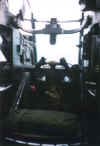
B-24 Tail Turret
Turning around and moving forward into the waist section, I looked at the others huddled around the guns and could see in my mind the gunners of 50 years ago, swinging their mounts around at the slashing enemy fighters. At that instant, it was easy for me to hear the thumping of the fifties firing and envision the brass flying from the guns, shining briefly in the light, and cascading across the floor.
I recalled that the day before, a vet had told me a story about one mission when he and the other waist gunner found themselves up to their shins with spent casings and how when they landed, almost all of the gun barrels had to be replaced and repaired, since several had actually come close to melting from the sustained firing.
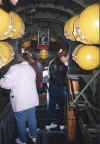
From the Walkway to the Tail, Looking Forward
at the Waist Positions, the Ball Turret Mechanism,
and Behind It, Our Bench Seat.
As I looked down, I realized that I was stepping on the floor hatch door, and that uneasy feeling was slightly diminished by the amazing sight of a highway below through a small circular window in the door. I couldn’t even imagine a tale that the POW vet had told me in the rain the day before. After the Focke-Wulf’s cannon shells ripped into his plane, the B-24 spiraled down from 25,000 to 10,000 feet. With all of his might, he crawled and grabbed his way to this very same hatch and hurled himself out into the European sky. Today, I don’t think I’d have the foresight to even look for a latch, but all but one of his crew had somehow escaped their certain death in the out-of-control B-24.

Long Way Down…the Floor Hatch
I worked my way back to the waist and soaked in the sights as we gently rocked up and down, left and right. For the next 35 minutes, we essentially flew southwest along Interstate 84, passing the University of Connecticut Health Center, New Britain, and over to Bristol, home of ESPN and Lake Compounce Amusement Park. Both were clearly visible from our altitude, which I never got for sure, but guessed to be about 2,000 feet.

Bristol, CT (ESPN at center near fork in road)
The view was great because the fall foliage was just reaching an early peak, and I soon realized that we would pass almost directly over my house. Within seconds, we were over it, up past the long glacial ridge that overlooks our town, and heading towards the Brass City…Waterbury, Connecticut.


Southington and Wolcott, CT

Waterbury, CT
In a matter of minutes, we were over the city, with all of us snapping photos wildly. Along I-84 above the picturesque town of Middlebury, I climbed back into the tail section, and noticed that Nine-O-Nine had caught up to us. I swore to myself when I saw that I was down to two shots on this roll of film and when I realized what was happening….she was moving into a formation with us.
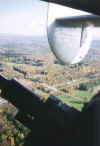
I-84 in Middlebury, CT
I quickly shot two pictures of the floor, slapped another roll of film in the camera, and scrambled back to the waist, where everyone was now busy shooting the B-17 moving in closer. Having a slight height advantage, I got my camera up just in time to see it move in behind our starboard tail…two awesome machines moving as one. I remembered my grandfather telling me his awe of the sight of hundreds of B-24s in formation heading towards their target, and I got a small, small taste of it at that moment. It was humbling and gave me a chill that I still have as I write this article.


Nine-O-Nine Catching Up
Nine-O-Nine pulled away slightly, and we got the klaxon that it was time to buckle back up. None of us rushed, but we all made our way back to the seats, fastened ourselves in, and watched the beautiful foliage get closer and closer to our precious airframe.
With a very slight thud, the wheels screeched a little, the nose settled down, and “The Dragon and His Tail” belonged to the earth again. As we came to a stop, the bomb bay doors opened and Bill came knocking, urging us to move out quickly. I made sure I had everything with me and got out the way I came in; through the small door, onto the catwalk, and down a small jump to the tarmac below.
As I crouched under the bomb bay doors and looked out at the crowd assembled, I got choked up at the site of about 50 vets standing there, many in their unit hats, American Legion caps, or unit shirts. I considered how lucky I felt today going up in the B-24, and imagined how unlucky they may have felt more than 50 years ago, flying into the enemy’s teeth day after day after day. As I walked towards them, a group was already assembled to head out to The Dragon and go for their ride. I turned around and caught Nine-O-Nine taxiing in behind.

On the Ground at Waterbury-Oxford Airport

“The Dragon and His Tail” Taking Off
As I made my way to the crowd, a wide-eyed little boy, maybe 10 or 11, asked, “How was it?”
“Awesome.” At the same time I said it, a vet next to him did as well. His B-24 hat proudly had a number of pins on it, and I knew in my heart that only someone like him could really understand how incredible I felt at that moment.
It’s one thing to read about history, but the flight on board “The Dragon and His Tail” was living a small piece of it. I would encourage anyone who has the chance to see or ride these magnificent aircraft to do so while they can. Thanks to the folks at the Collings Foundation and our active vets, today we have the chance to get a small taste of how it was to fly in the skies over World War II. I have not a sliver of doubt that we’re all the better for it.
For more information about the Collings Foundation and its aircraft, contact them at:
The Collings Foundation
River Hill Farm
Stow, MA 01775 USA
(978) 562-9182
Or visit their web site at: http://www.collingsfoundation.org
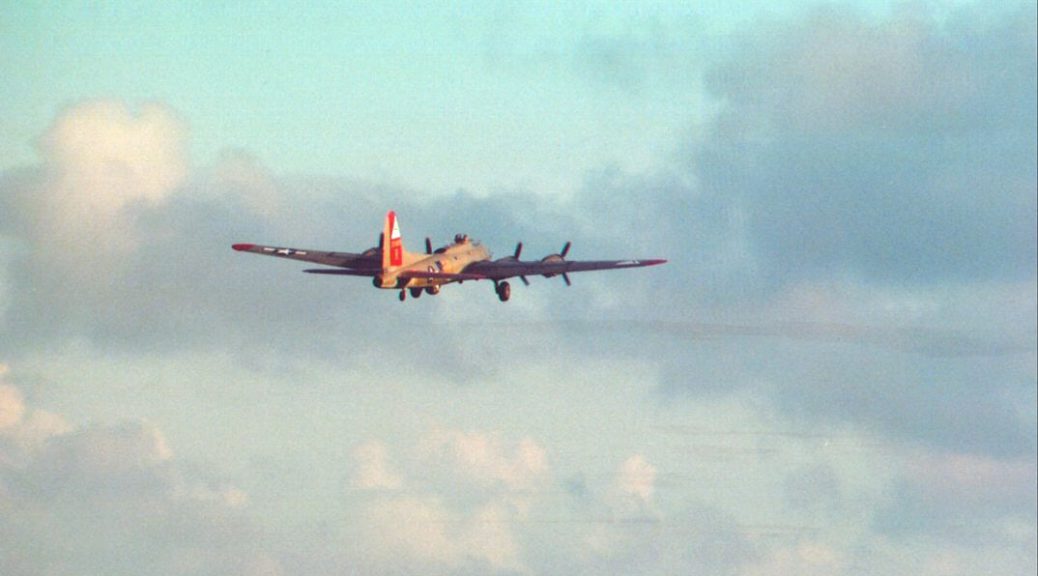
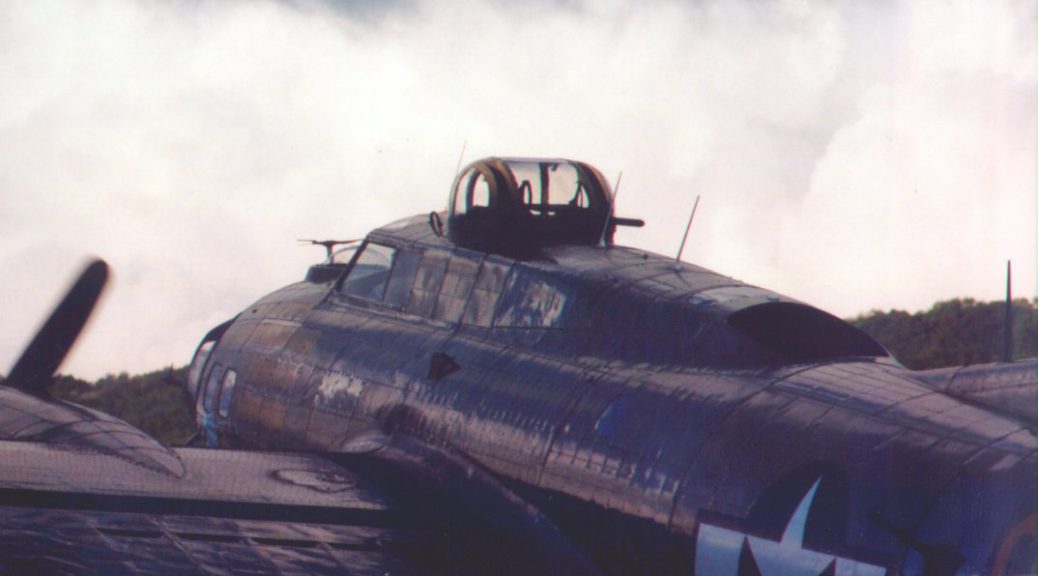



























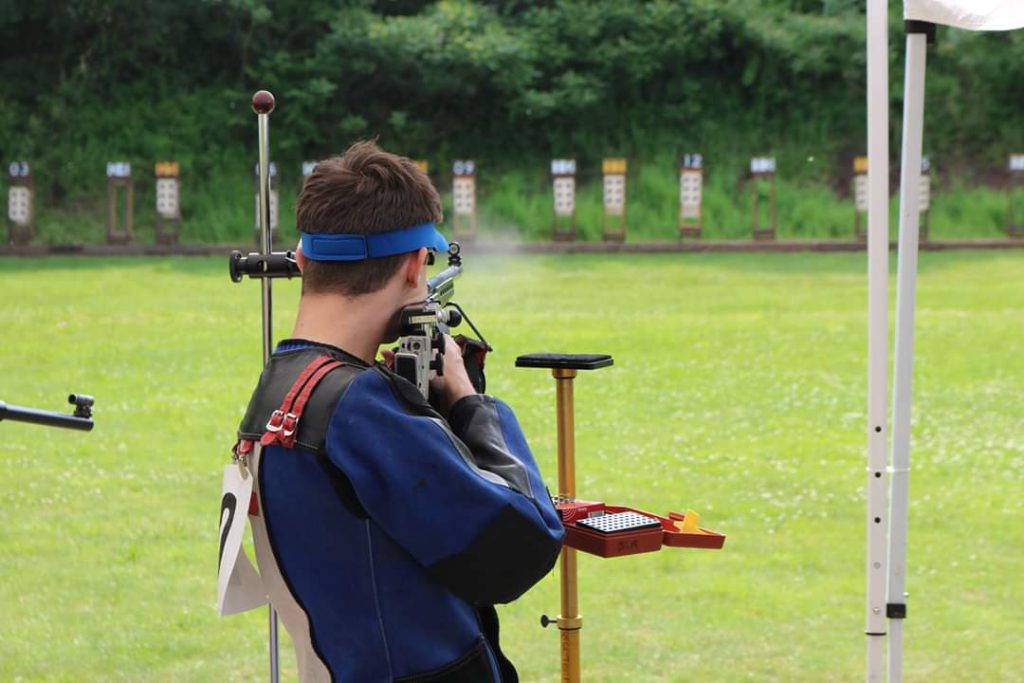









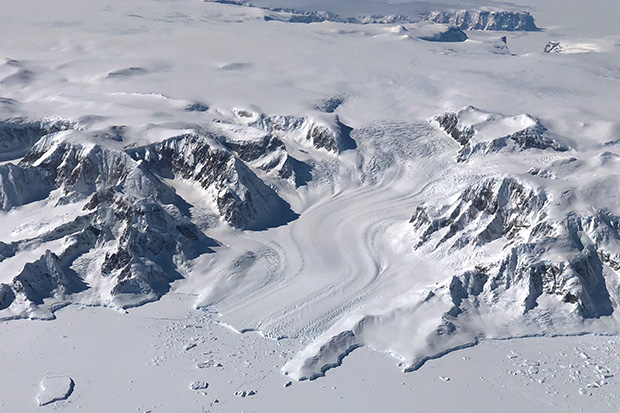
 I did not know of Henry Worsley before last week, but it’s been difficult to get him out of my mind since. He died on January 24, just 30 miles short of his goal but after traversing more than 900 miles of Antarctica on foot, seeking to honor his inspiration, famed explorer Ernest Shackleton. Worsley was much more than an explorer, it turns out. He was a philanthropist, raising money for wounded soldiers. He was also himself a combat-decorated warrior, rising to the elite of the British special forces and spending a career on the knife’s edge.
I did not know of Henry Worsley before last week, but it’s been difficult to get him out of my mind since. He died on January 24, just 30 miles short of his goal but after traversing more than 900 miles of Antarctica on foot, seeking to honor his inspiration, famed explorer Ernest Shackleton. Worsley was much more than an explorer, it turns out. He was a philanthropist, raising money for wounded soldiers. He was also himself a combat-decorated warrior, rising to the elite of the British special forces and spending a career on the knife’s edge.







